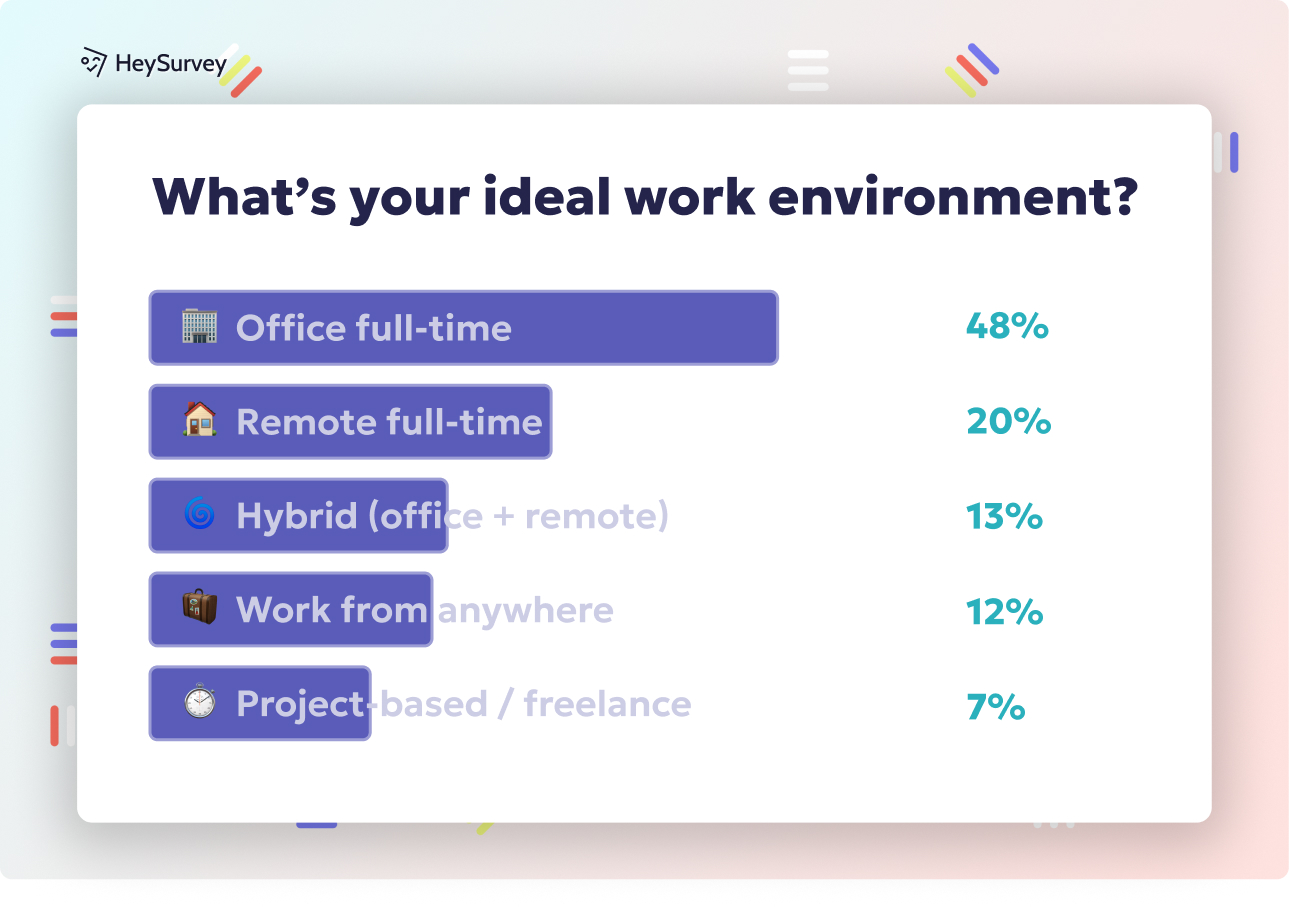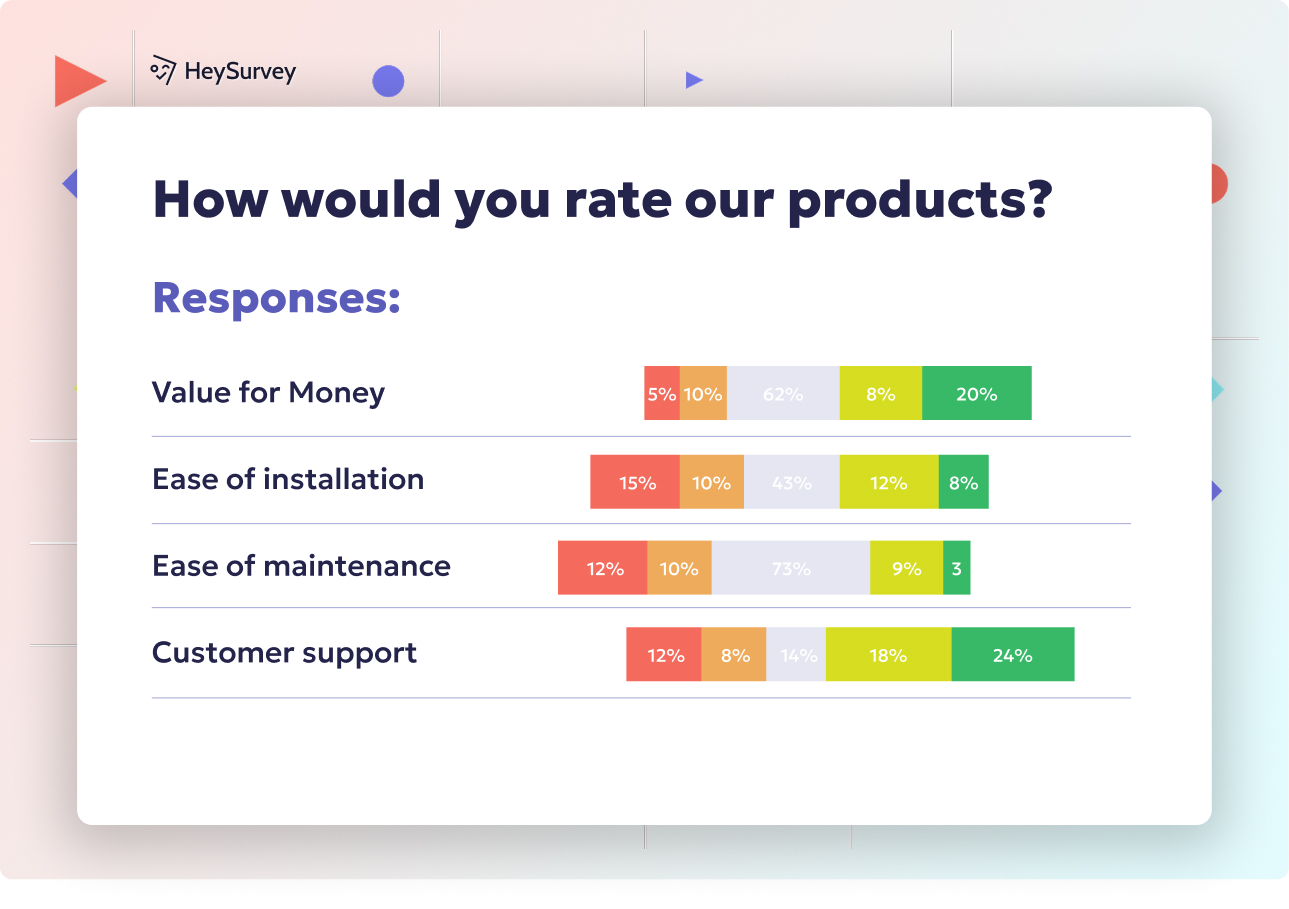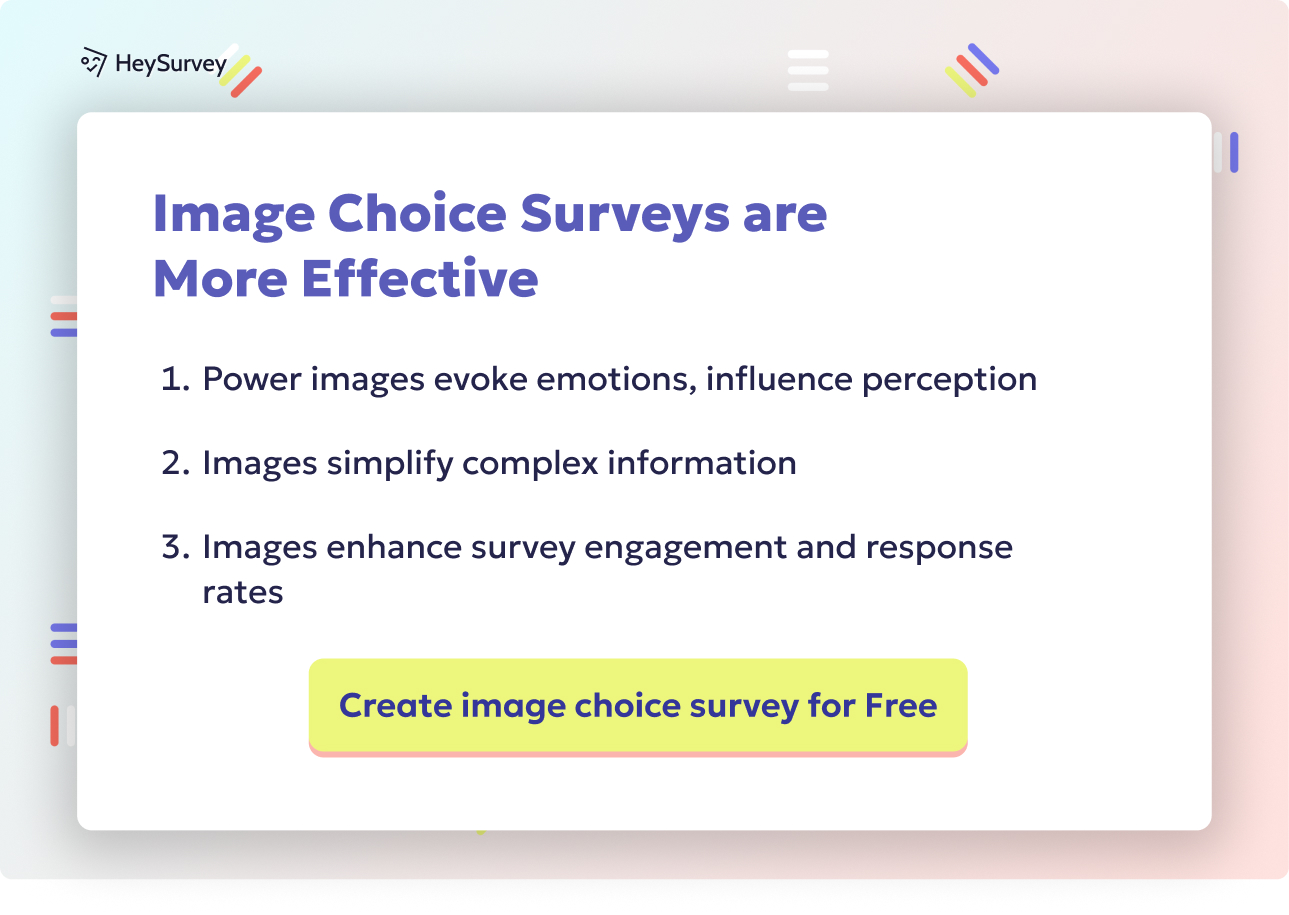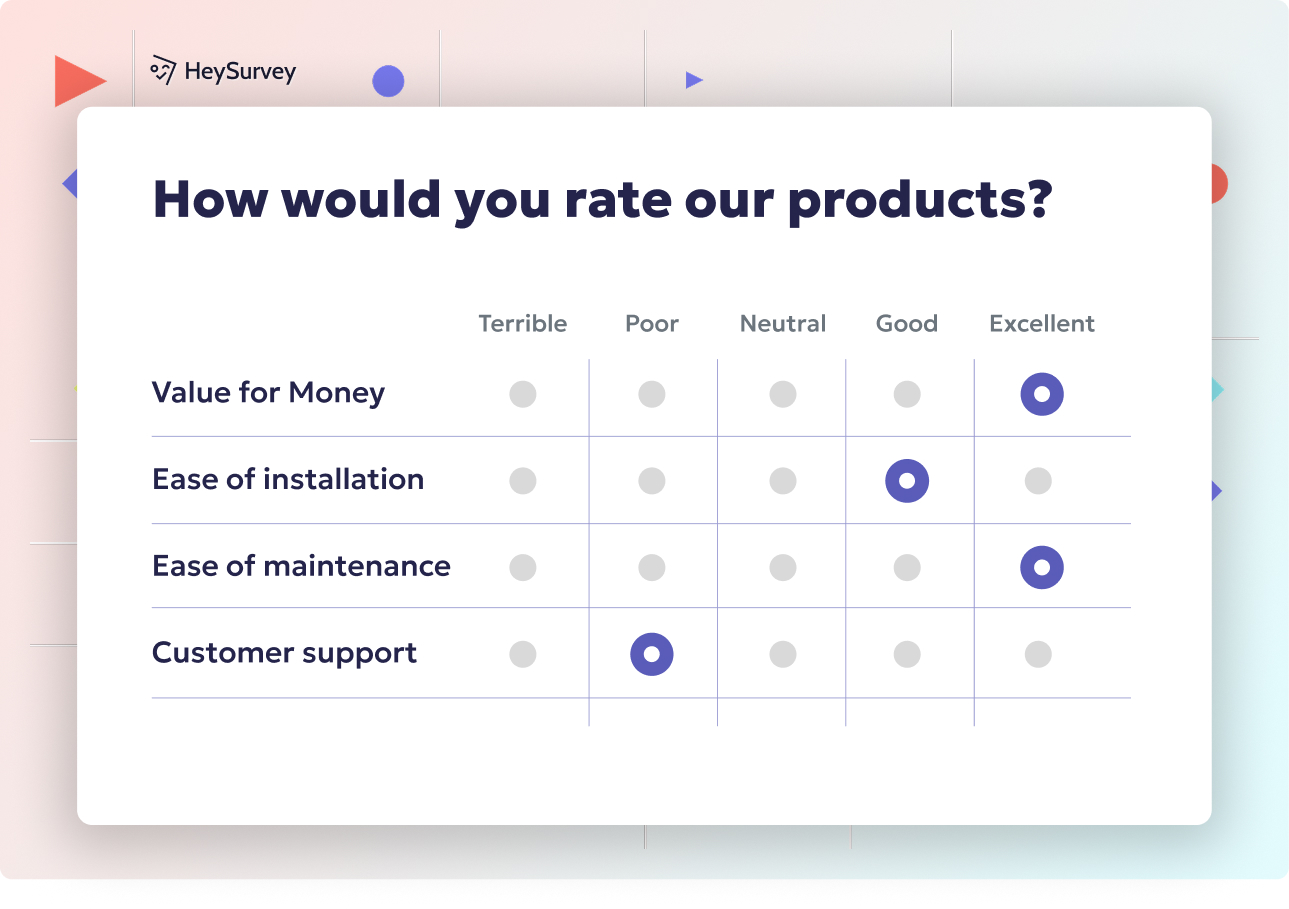29 Tips for Designing Quality Survey Questions That Convert
Discover expert tips on designing quality survey questions with 27 sample questions across 8 types for clearer insights and higher response rates.
Survey question design is the art and science of crafting questions that gather meaningful data, drive high response rates, and power better business decisions. Whether you’re planning market research, gauging employee engagement, collecting customer feedback, or supporting academic studies, the quality of your survey questions directly impacts your results. From multiple-choice to open-ended formats, learning to match the right question type to the job boosts both completion rates and the depth of your insights.
Multiple-Choice (Single-Select) Questions
What Are Multiple-Choice (Single-Select) Questions?
Single-select survey questions ask respondents to pick just one option from a concise list. This question type shines in situations where you want to learn someone’s clear favorite or primary habit. For example, you'd use them for surveys on product preference, where only one answer is needed—no ambiguity, no overlap, just one choice.
They're practical in the real world:
- Pinpointing which product features customers use most
- Choosing the biggest barrier for adoption
- Determining a single source for news consumption
- Surveying favorite lunch options in the cafeteria
- Assessing the most preferred time for a workshop
With clear options, you see patterns in choices at a glance.
Why & When to Use Multiple-Choice (Single-Select) Questions
Use multiple-choice survey example questions when you need answers that are:
- Quick to analyze
- Mutually exclusive
- Easy to display on both desktop and mobile devices
They’re perfect for rapid insights because they force respondents to make just one decision. Analysis becomes a walk in the park – you can instantly see which response is most popular.
Choose this survey question type in these scenarios:
- When each answer must be distinct
- When you're aiming for mobile-friendly, low-effort experiences
- For dashboards that display clean, count-based charts
A well-worded single-select makes your data tidy and actionable every time.
5+ Sample Multiple-Choice (Single-Select) Survey Questions
- Which of the following features do you use most often?
- What is the main reason you chose our service?
- Which season do you prefer for vacations?
- What type of device do you primarily use to access our site?
- How did you first hear about us?
- What is your favorite style of cuisine?
Crafting multiple-choice questions with clear, concise stems and plausible distractors enhances assessment reliability and validity. (uwaterloo.ca)

Creating your perfect survey with HeySurvey is easier than you might think! Here’s how to get started in just three simple steps:
Step 1: Create a New Survey
- Head to HeySurvey and click Create New Survey to start fresh.
- If you prefer, pick from one of the handy pre-built templates tailored for different purposes—this will save you time and give you a solid structure.
- Give your survey a name so you can easily find it later in your dashboard.
Step 2: Add Questions
- Click Add Question to start building your survey one step at a time.
- Choose from question types like Multiple Choice, Likert Scale, Rating Scale, Ranking, Semantic Differential, or Open-Ended, depending on the insights you want.
- Enter your question text and customize the answer options as needed—add images, set required fields, or enable multiple selections.
- If your survey needs paths that change depending on answers, easily set up branching right here to tailor the experience.
Step 3: Publish Your Survey
- Once you’ve added all your questions and reviewed your survey in preview mode, hit Publish.
- You’ll get a sharable link to send out, or cut-and-paste the embed code to place the survey right on your website.
- Remember, you need an account to publish surveys and view responses, so sign up or log in if you haven’t already.
Bonus Step 1: Apply Your Branding
- To make your survey truly yours, upload your logo and customize colors and fonts in the Designer Sidebar.
- Set backgrounds or add animations to keep your survey visually engaging.
Bonus Step 2: Define Important Settings
- Use the Settings Panel to set start and end dates, control how many responses you want to collect, or set up a redirect URL for respondents after finishing.
- Choose whether respondents can view results or not, depending on how you want to share feedback.
Bonus Step 3: Skip Into Branches
- Enhance your survey by adding conditional logic so that respondents jump to specific questions based on their previous answers.
- This makes longer or complex surveys feel personal and relevant, reducing drop-off and making data cleaner.
Ready to give it a whirl? Just click the button below to open a template and build your survey with HeySurvey’s friendly tools guiding you every step of the way!
Likert Scale Questions
What Are Likert Scale Questions?
A Likert scale survey uses either 5 or 7 response options to measure attitudes or satisfaction. The respondent assesses how much they agree or disagree with a statement, or how satisfied they are with an experience. This scale enables you to spot not just what people think, but also how intensely they feel it.
It’s a staple for:
- Employee engagement surveys
- Customer satisfaction
- Product usability studies
- Event feedback forms
The beauty of agreement scale questions is their subtlety—you catch degrees of feeling, not just a thumbs up or down.
Why & When to Use Likert Scale Questions
Likert question examples are essential for measuring the energy behind your audience’s opinions. Use them when you want to:
- Track how perceptions shift over time
- Benchmark performance
- Understand subtle variations in sentiment
The Likert scale survey is perfect for longitudinal studies or trend analysis because the numbers let you compare responses at a glance. You’ll also see where you’re meeting, exceeding, or falling short of expectations, making this scale a core ingredient in high-quality survey design.
Deploy them for:
- Ongoing employee happiness reports
- Comparing satisfaction levels year-over-year
- Pinpointing areas for incremental improvement
Since respondents can share the intensity of their views, you get access to the true flavor of their experience.
5+ Sample Likert Scale Survey Questions
- I find the new dashboard easy to navigate – Strongly Disagree, Disagree, Neutral, Agree, Strongly Agree.
- The team communicates effectively – Strongly Disagree to Strongly Agree.
- I am satisfied with the range of products available – Strongly Disagree to Strongly Agree.
- The product met my expectations – Strongly Disagree to Strongly Agree.
- I feel valued as a customer – Strongly Disagree to Strongly Agree.
- The website loads quickly on my device – Strongly Disagree to Strongly Agree.
Using an odd-numbered Likert scale, such as a 5-point or 7-point scale, enhances data quality by providing a neutral midpoint, allowing respondents to express neutrality or ambivalence. (bestpractices.net)
Numeric Rating Scale Questions (0–10, 1–5, NPS)
What Are Numeric Rating Scale Questions?
Rating scale surveys use a series of numbers, often from 0–10 or 1–5, to let respondents grade their experiences. Unlike the Likert scale—which focuses on agreement—these scales deliver raw numbers for easier comparison, industry benchmarking, and tracking progress. The star of this category is the NPS question—the famous “How likely are you to recommend?” query.
Common uses include:
- Customer loyalty tracking
- Product review collection
- Gauging service satisfaction
- Running before-and-after assessments
0-10 rating question formats are especially useful when you need granular, quantifiable feedback.
Why & When to Use Numeric Rating Scale Questions
Choose numeric rating scale questions when precise measurement is your goal. They're ideal for:
- Calculating averages, trends, and net promoter scores
- Creating industry benchmarks
- Comparing performance across teams, products, or time periods
When you ask “How likely are you to recommend us on a scale of 0–10?” you get a single number that is instantly comparable to industry standards. They’re supercharged for statistical analysis and easy graphing.
Use them for:
- Baseline measurements before a new rollout
- After-service customer evaluations
- Peer comparisons
- Identifying super fans or warning zones
Letting people pick a number gives you potent, data-rich insights.
5+ Sample Numeric Rating Scale Survey Questions
- On a scale of 0–10, how likely are you to recommend our service to a friend?
- How would you rate your overall satisfaction with your purchase? (1–5)
- How likely are you to return to our website? (0–10)
- Rate the helpfulness of our support team. (1–5)
- On a scale of 0–10, how likely are you to try our new product?
- Please rate the cleanliness of our facility. (1–5)
Ranking Questions
What Are Ranking Questions?
With ranking survey questions, respondents are asked to put a list of items in a particular order, usually from most to least preferred. This is not the same as rating—here, you require people to truly prioritize, creating a “who’s best” leaderboard.
You’ll use ranking for:
- Deciding which products to launch next
- Creating feature roadmaps
- Allocating resources in fast-paced projects
The drag-and-drop ranking style can be delightfully interactive, making respondents part of the decision fun.
Why & When to Use Ranking Questions
Choose ranking survey questions to sort out what matters most to your audience. They’re fabulous for:
- Prioritization studies
- Feature ranking in development sprints
- Deciding which events, perks, or add-ons should come first
The beauty of ranking is that it takes the guesswork out of “what’s pretty good” versus “what’s best.” You get a pecking order, not just a list of likes, so strategizing becomes much clearer.
Use them for:
- New product rollouts and roadmap planning
- Customer preference studies
- Resource allocation boards
- Finding favorite extras or add-ons
With each response, you get a crystal-clear rundown of priorities.
5+ Sample Ranking Survey Questions
- Please rank the following delivery options from most to least preferred.
- Rank these smartphone features: battery life, camera quality, price, screen size, brand.
- Put these activities in order of how often you do them: running, yoga, swimming, biking.
- Rank the following causes in order of importance to you: environment, education, healthcare, animal welfare.
- Sort these store sections based on where you spend the most time: apparel, electronics, groceries, home goods.
- Please order these social media platforms by how often you use them.
Limiting ranking questions to between 6 and 10 items enhances reliability, as respondents provide more consistent rankings for top and bottom items, while middle rankings tend to be less reliable. (qualtrics.com)
Semantic Differential Questions
What Are Semantic Differential Questions?
Semantic differential scale questions use a pair of opposite adjectives, such as “Unhelpful—Helpful” or “Dull—Exciting,” spread across a line or a row of boxes. Respondents mark where their experience falls between these two ends. This visual, analog style lets you tap directly into perceptions and emotions.
They're especially useful for:
- Assessing brand image
- Testing user experience (UX) in digital products
- Measuring emotional responses to services or ads
It’s the go-to bipolar adjective survey for understanding what “feel” your brand, product, or service creates.
Why & When to Use Semantic Differential Questions
Use semantic differential scale questions when you need more nuance than a simple yes/no or agree/disagree. They reveal exactly where perceptions live between two extremes.
Prefer them for:
- Brand perception audits
- Early-phase UX testing
- Capturing user emotions quickly
Semantic differential survey items work wonders in market research and design validation. With their visual, analog style, they’re easy for users to understand and respond to, and they tap straight into gut feelings.
Deploy them in contexts like:
- Evaluating app usability and emotional tone
- Tracking shifts in perception after a campaign
- Pinpointing emotional hotspots for design adjustments
These questions offer a sliding scale of truth—from love to meh to dislike.
5+ Sample Semantic Differential Survey Questions
- Rate our app on the following scale: Unintuitive ___ ___ ___ ___ ___ Intuitive.
- Please indicate how our customer service felt: Unfriendly ___ ___ ___ ___ ___ Friendly.
- How do you perceive our brand? Old-fashioned ___ ___ ___ ___ ___ Modern.
- Rate your website experience: Stressful ___ ___ ___ ___ ___ Relaxing.
- Please rate the checkout process: Complicated ___ ___ ___ ___ ___ Simple.
- How is our packaging? Boring ___ ___ ___ ___ ___ Fun.
Open-Ended (Free-Text) Questions
What Are Open-Ended (Free-Text) Questions?
Open-ended survey questions give respondents a blank box to share their thoughts, experiences, and feelings in their own words. No restrictions, no prompts—just pure qualitative insight.
This survey question type is fantastic for:
- Digging deeper into unique problems
- Catching feedback you never expected
- Uncovering sentiment in colorful, natural language
Text-analytics tools can turn these qualitative feedback questions into themes, but nothing beats reading real voices.
Why & When to Use Open-Ended (Free-Text) Questions
Use open-ended survey questions to find out what your set list of options can’t reveal. They’re gold for:
- Understanding why something matters
- Gaining context behind other answers
- Surfacing out-of-the-box ideas
Go open-ended when you want to capture raw opinions, vivid descriptions, or elaborate stories—not just checkboxes. It’s the channel for both kudos and constructive criticism.
Best for:
- Final questions in a survey to invite last comments
- Digging into pain points after a poor rating
- Brainstorming “what’s next” features
Free-text questions reveal the real “why,” not just the “what.”
5+ Sample Open-Ended Survey Questions
- What is one thing we could improve about the checkout process?
- Please describe your ideal customer experience with our company.
- Is there any feature you wish we offered but currently do not?
- What did you like least about your last visit?
- What else would you like to share with us?
- Describe a memorable interaction you had with our staff.
Demographic & Screening Questions
What Are Demographic & Screening Questions?
Demographic survey questions capture details like age, job title, education, or location, while screening questions for surveys are used to ensure only certain people proceed. Together, these questions are foundational for targeting, quota control, and in-depth data segmentation.
These questions help:
- Balance samples by age, gender, or experience
- Target niche audiences
- Create more relevant follow-up pathways
They transform generic surveys into smart, customized experiences.
Why & When to Use Demographic & Screening Questions
Employ demographic and screening questions when your survey depends on reaching the right respondents—or when you’re segmenting results for richer stories.
Best practices include:
- Placing screening questions up front for quota control
- Using demographics at the end to minimize drop-off
- Keeping all items optional when possible
Use them when you must:
- Filter participants based on qualification criteria
- Balance ages, roles, or locations for representative data
- Enable cross-tab analysis by subgroup
These questions ensure your insights aren’t skewed by the wrong crowd.
5+ Sample Demographic & Screening Survey Questions
- Which age bracket best describes you?
- What is your current employment status?
- What is the highest level of education you have completed?
- In which country do you currently reside?
- What is your household income range?
- Before continuing, have you purchased from us in the last six months? (Yes/No)
Best Practices & Common Dos and Don’ts
Survey Design Dos and Don’ts
Getting survey design best practices right is essential for strong data. Start every survey with simple questions to warm up respondents, saving tricky items for later. Strive for words that are clear, concise, and bias-free.
Follow these dos and don’ts:
- Do use neutral wording—no leading language or loaded phrases.
- Do keep scales balanced (if “Strongly Agree” is present, so must “Strongly Disagree”).
- Do avoid double-barreled questions (never ask about two things at once).
- Do use the funnel approach—broad to specific—to help users find their survey groove.
- Do optimize for mobile screens—short questions, large tap zones, and minimal scrolling.
- Do check for accessibility: support screen readers, use high-contrast colors, and add alt text to images.
Don’t forget:
- Don’t overload your survey—fewer, better questions reduce fatigue.
- Don’t force respondents to answer every question (unless necessary for logic).
- Don’t use jargon, acronyms, or inside jokes—keep it friendly and universal.
- Don’t add unnecessary graphics or animations that could distract or confuse.
By sidestepping bias and confusion, you achieve true high-quality survey design and data you can trust.
Well-designed questions serve up clearer data, higher completion, and more trustworthy decisions. When you get both the question type and the wording just right, there’s magic in those responses—so survey on, question maestro! Every click, drag, or tap paves the way to sharper insights and more confident next moves.
Related Question Design Surveys

29 Quantitative Survey Research Questions Example for Success
Explore 25+ quantitative survey research questions example with clear explanations and tips for c...

32 Good Survey Question to Boost Your Data Quality
Discover how to craft good survey questions with 30 sample questions across 8 types for better da...

31 Survey Question Mistakes You Need to Avoid Today
Discover 25 common survey questions mistakes with real examples and expert tips to craft clear, u...

